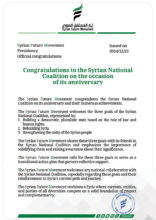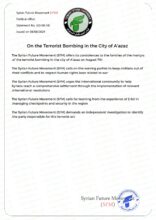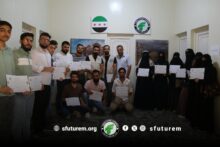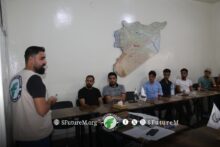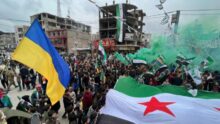A Look at the General National Conference

Introduction:
Before liberation, we were among those advocating for a national dialogue table with the de facto authorities to reach a genuine and natural Syrian solution. The goal of this dialogue was to preserve Syria’s map from division and to reunite the Syrian people within a single framework and a new social contract.
The Syrian Future Movement was among those who supported every proposal for dialogue in Syria, including the experience of West Germany and the unification of areas outside the control of the former regime.
With the honorable military liberation and victory, and the entry into Damascus by unified military factions from the north and south under joint operations rooms, the new administration assumed power in Damascus. It took over responsibilities from the former regime’s government and transferred all the transitional government’s powers to the Salvation Government in Idlib. This arrangement is part of interim operations that will conclude at the beginning of the third month of the coming year, leading to the convening of a General National Conference that will establish a fully empowered legitimate government.
The History of National Conferences in Syria:
Syria has witnessed several national conferences throughout its history, most notably:
- The Syrian General Conference (1919-1920): Held in Damascus after the fall of the Ottoman Empire, this conference aimed to discuss the future of Greater Syria. Representatives from various Syrian regions, including Lebanon, Jordan, and Palestine, participated. During this conference, Syria’s independence was declared under the name “The Arab Kingdom of Syria,” with Prince Faisal bin Al-Hussein installed as its king.
- The Homs Conference (1920): Convened to address Syria’s political situation following the declaration of the French Mandate, this conference sought to unify Syrian ranks against the mandate.
- The Aleppo Conference (1920): This conference also focused on the issues discussed at the Homs Conference, aiming to strengthen national unity and resist the French Mandate.
These conferences were attempts to unify Syrian ranks and determine the country’s future amidst political challenges and foreign occupations.
Following the national conferences held in the early 20th century, Syria witnessed several other conferences and efforts to bring together political and social factions, especially during times of crises and challenges. Among the most prominent of these conferences are:
- Geneva Conference (2012-2014): Several rounds of talks were held in Geneva under the auspices of the United Nations, aiming to find a political solution to the Syrian crisis. Representatives of the former Syrian regime, the opposition, and the international community participated in these talks.
- Sochi Conference (2018): Held in the Russian city of Sochi with the participation of representatives from the Syrian regime, the opposition, and some armed factions. The conference aimed to discuss Syria’s future and draft a new constitution for the country.
- Astana Conference (2017-2019): A series of talks held in the Kazakh capital Astana (now Nur-Sultan) with representatives of the former Syrian regime, the opposition, and armed factions, along with the guarantor states (Russia, Turkey, and Iran). These talks focused on ceasefire agreements and confidence-building measures between the conflicting parties.
These conferences were attempts to bring together various Syrian parties and reach political solutions to the ongoing crisis. They sought to form a national conference under external auspices but failed to establish a comprehensive solution despite some positive aspects.
The Authentic Syrian Conferences:
At the beginning of the Syrian revolution, several national conferences were held away from Bashar al-Assad’s regime after losing hope in cooperation with it. These conferences aimed to unite various factions and seek political solutions to the escalating crisis. Among the most notable of these conferences:
- Antalya Conference (June 2011): Held in the Turkish city of Antalya, it brought together representatives of the Syrian opposition from inside and outside the country. The conference aimed to unify the opposition and establish a shared vision for Syria’s future after the regime’s fall.
- Istanbul Conference (August 2011): This conference saw broad participation from the Syrian opposition and resulted in the announcement of the formation of the Syrian National Council, intended to represent the opposition and coordinate its efforts on the international stage.
- Cairo Conference (July 2012): Organized by the Arab League in Cairo, this conference included representatives from the Syrian opposition and civil society. It aimed to establish a roadmap for Syria’s transitional phase and resulted in the agreement on the National Covenant document, which outlined fundamental principles for managing the transitional period.
These conferences were attempts to unify the Syrian opposition and lay the groundwork for a political solution to the crisis. However, they faced significant challenges due to internal divisions and external interference.
Preliminary Meetings for the Upcoming Conference in Damascus 2025:
The Syrian National Conference, scheduled for early 2025, aims to bring together all political and social factions in Syria, including representatives from military and revolutionary groups, to create a roadmap for the transitional phase and manage the state’s affairs in the coming period. Preparations are currently underway intensively, and the conference is expected to include representatives from civil society, academic experts, and independents.
What has been indicated to us is that the process of selecting participants for the Syrian National Conference will be inclusive and diverse to ensure the representation of all political and social sectors. Based on our observations, the selection process will proceed as follows:
- Political Representatives: Representatives from various political parties will be invited, including opposition groups and remnants of the former Syrian regime who have not been involved in the bloodshed, to ensure broad political representation.
- Military and Revolutionary Factions: Representatives from military and revolutionary factions that have influence on the ground will be selected to ensure active participation in the dialogue.
- Civil Society: Civil society organizations and activists will be invited to ensure representation of social and humanitarian issues.
- Academic Experts and Independents: Experts in various fields such as economics, law, and administration will be selected to provide scientific and professional insights.
- Geographical Representation: Geographical representation will be taken into account to ensure the participation of all Syrian regions.
It is expected that this upcoming national conference, scheduled to be held at the beginning of 2025, will be the first of its kind since the Syrian revolution. The goal of this conference is to bring together all political and social factions to create a roadmap for the transitional phase and to manage the affairs of the state in the coming period.
Benefiting from Previous Experiences:
The most notable experimental example of holding a national conference is the Sahara Conference, which was sponsored by Farouk al-Sharaa in 2011. It was an attempt to initiate a national dialogue at the beginning of the Syrian revolution. The conference was held at the Sahara Hotel in Damascus and was attended by several political figures, intellectuals, and some representatives of the internal opposition. The goal of the conference was to discuss the political situation and attempt to find solutions to the escalating crisis at that time.
However, this conference was not considered a truly comprehensive national conference, as it did not include all political and social factions in Syria, nor did it achieve tangible results in halting the violence or reaching comprehensive political solutions. The conference was seen as an attempt by the regime to contain the crisis and show its willingness for dialogue, but it did not fully achieve its objectives.
To overcome the reasons behind the failure of the Sahara Conference and ensure the success of the new national conference, several steps can be taken, drawing from previous experiences:
- Inclusive representation: Ensuring the participation of all political and social factions, including both internal and external opposition, military factions, and civil society organizations. This guarantees that the decisions made are representative of all Syrians.
- Transparency and credibility: The preparation process for the conference must be transparent, with clear information provided about the goals and procedures. This will build trust among participants and ensure their commitment to the outcomes.
- Independence: Ensuring there is no external interference or political pressure, to guarantee that the decisions stem from the will of the Syrians themselves.
- Confidence-building measures: Establishing trust between the various parties involved.
- Establishing a clear mechanism for following up on and implementing the decisions made at the conference, with clear responsibilities and a timeline for execution.
- Learning from previous experiences: Studying the reasons behind the failure of the Sahara Conference and other past conferences to avoid the same mistakes. For instance, avoiding focusing on formal dialogue without achieving tangible results.
By implementing these steps, the experience of the Sahara Conference can be turned into a positive lesson that contributes to the success of the new national conference and achieving its goals in building a better future for Syria.
Conclusion:
It goes without saying that the success of this phase is a critical and national issue that rests upon all of us. Therefore, every effort must be made to ensure the success of the national conference, which will shape our new state and define its future parameters.
It is essential to build trust among the various parties, and for all parties to commit to sincere and open dialogue, where every voice and opinion is listened to seriously and respectfully. Additionally, all parties must commit to the agreements reached during the conference, which will strengthen trust and establish an environment of sustainable cooperation.
It is also important to create effective mechanisms for monitoring the implementation of decisions and agreements, ensuring adherence and achieving the desired goals. Building trust is the foundation upon which any real and sustainable progress in Syria can be built, as it helps overcome differences and creates a shared future for all Syrians.
For the success of the national conference in Syria, there are several recommendations that we see in the Research and Studies section of the Political Bureau of the Syrian Future Movement, which we hope will be a national contribution from us to broaden the vision of the Syrian decision-makers:
- Fair representation, which is achieved through:
- A. Distribution of representation, meaning that the representation within the conference should be based on fair criteria that consider the balance between different Syrian regions and components, including ethnic and religious minorities.
- B. Preventing any party from monopolizing decisions to ensure that the outcomes of the conference reflect national consensus.
- Agenda, which is addressed through:
- A. Setting priorities, ensuring that the agenda includes essential issues such as rebuilding institutions, transitional justice, human rights, and economic reconstruction.
- B. Ensuring the agenda is flexible enough to accommodate urgent issues and new developments.
- Subcommittees, represented by:
- A. Forming specialized committees to address various issues such as security, economy, transitional justice, and the new constitution.
- B. Selecting committee members based on competence and experience to ensure the effectiveness of the work and the achievement of the desired results.
Transparency and participation, through a decision-making process that is transparent and open to all, to ensure trust and credibility. Additionally, involving civil society and citizens in the process to ensure that decisions reflect the aspirations of the Syrian people.
International support, by working to build international relationships that support Syria’s national interests and assist in achieving stability and reconstruction.
We believe that these recommendations can help ensure the success of the national conference and achieve its goals in building a new Syria based on the principles of democracy, justice, and popular participation.
We also call on researchers and thinkers for further investigation and scrutiny, to reach a collective formula that helps decision-makers make the right decisions, so that we do not repeat our past failures and succeed in this phase, considering it as the labor of a new phase for Syria.
Political Office
Jomaa Mohammad Laheep
Director of the Research and Studies Department
Articles
Syrian Future Movement

